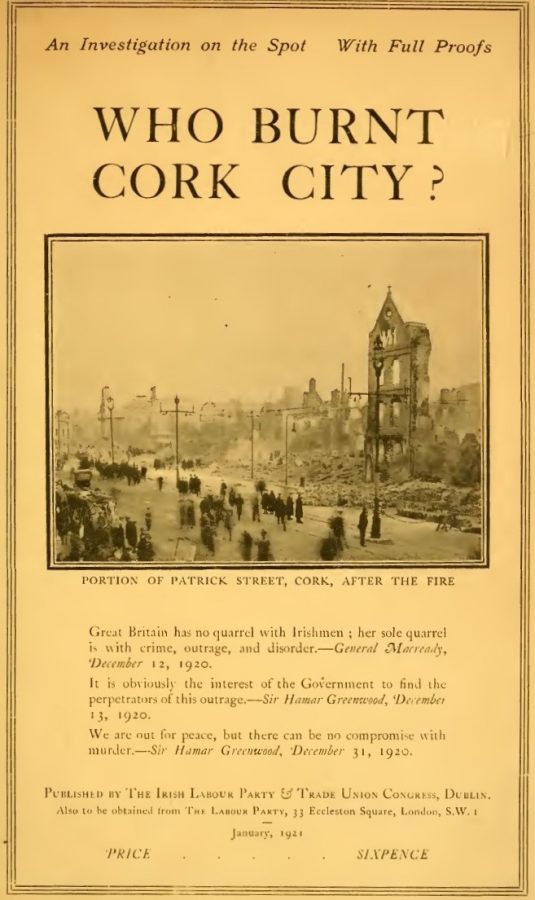8 January 2021, “Independent Cork city councillor Kieran McCarthy also welcomed the plans. ‘There is so much empty property within the city centre especially over the shops that would make great accommodation space plus also offer great prospects of urban renewal’, Cork City Council gives green light to apartment plans for Patrick Street,
Cork City Council gives green light to apartment plans for Patrick Street (echolive.ie)
Category Archives: Cork City Events
Cllr McCarthy commissions two new street art murals on Douglas Road, January 2021
Independent Cllr Kieran McCarthy continues his commissions of street art on Douglas Road. In recent weeks, two new pieces have emerged on traffic switch boxes. The first mural, which is located at Cross Douglas Road, is that of Terence and Muriel MacSwiney who lived at 5 Eldred Terrace in 1917.
Cllr McCarthy highlighted: “There was a commemorative plaque erected on the wall of their former house in June 1980 but unfortunately the plaque was taken down a few months later. There have been calls within the Ballinlough area and Douglas Road by locals to once again mark the story from over hundred years ago of the MacSwineys living within the local community. This mural’s central image is from an old photograph of the couple whist the rose motif is a nod to the always beautiful adjacent flower shop.
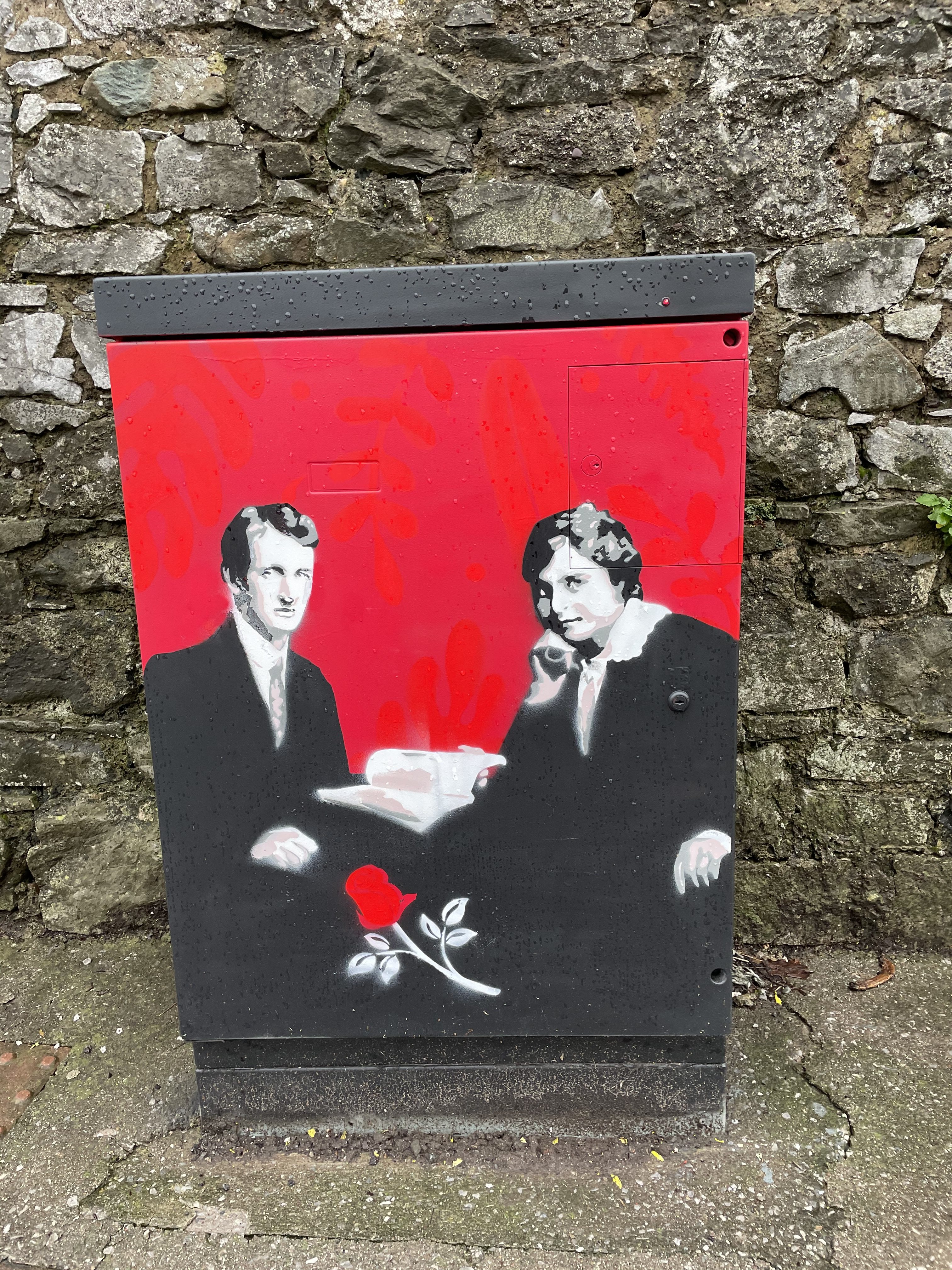
The second mural is opposite the entrance to St Finbarr’s Hospital. Cllr McCarthy noted: “The mural has the theme of “hold firm” and is dedicated to healthcare staff within the hospital who have held firm against COVID-19. The mural adds to the existing street art mural, which was painted Kevin O’Brien outside CUH last year”.
“It has been great to commission artist Kevin O’Brien again. This is my sixth commission with him. He really brings ordinary municipal utility boxes to life with his creativity, imparting uplifting and positives messages. Roads such as Douglas Road are well walked everyday, so it is great to bring his work into heart of suburban communities, concluded Cllr McCarthy.
Artist Kevin O’Brien noted: “Street art is a fantastic way to improve the aesthetic of urban areas and build a sense of character in communities, but beyond that, with cultural spaces currently closed, the availability of street art in public spaces takes on an even greater importance”.
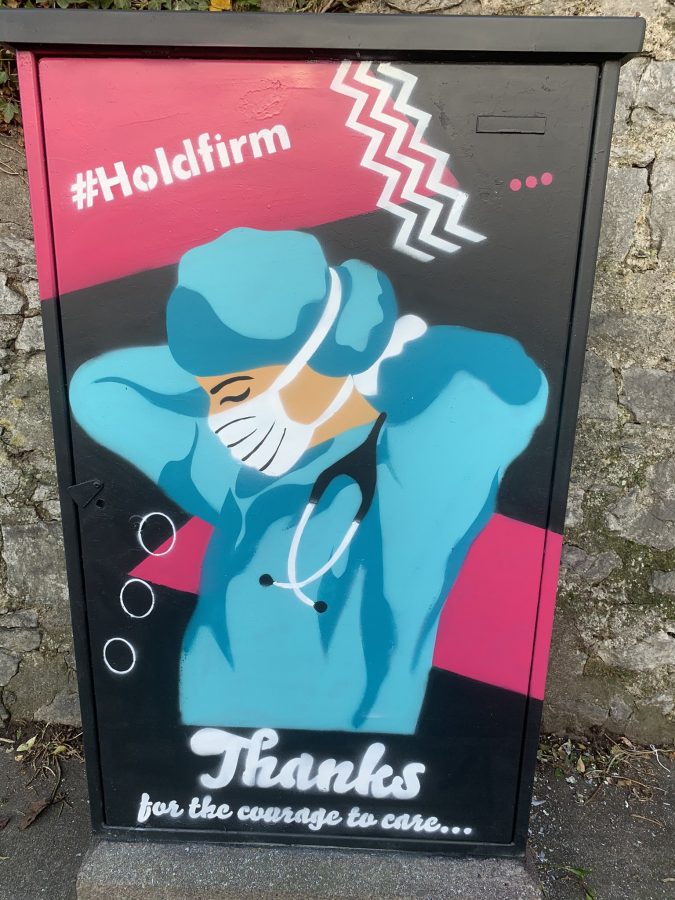
The Blessing of a Candle, Christmas 2020
by Cllr Kieran McCarthy
Sturdy on a table top and lit by youngest fair,
a candle is blessed with hope and love, and much festive cheer,
Set in a wooden centre piece galore,
it speaks in Christian mercy and a distant past of emotional lore,
With each commencing second, memories come and go,
like flickering lights on the nearest Christmas tree all lit in traditional glow,
With each passing minute, the flame bounces side to side in drafty household breeze,
its light conjuring feelings of peace and warmth amidst familiar blissful degrees,
With each lapsing hour, the residue of wax visibly melts away,
whilst the light blue centered heart is laced with a spiritual healing at play,
With each ending day, how lucky are those who love and laugh around its glow-filledness,
whilst outside, the cold beats against the nearest window in the bleak winter barreness,
Fear and nightmare drift away in the emulating light,
both threaten this season in almighty wintry flight,
Sturdy on a table top and lit by youngest fair,
a candle is blessed with hope and love, and much festive cheer.
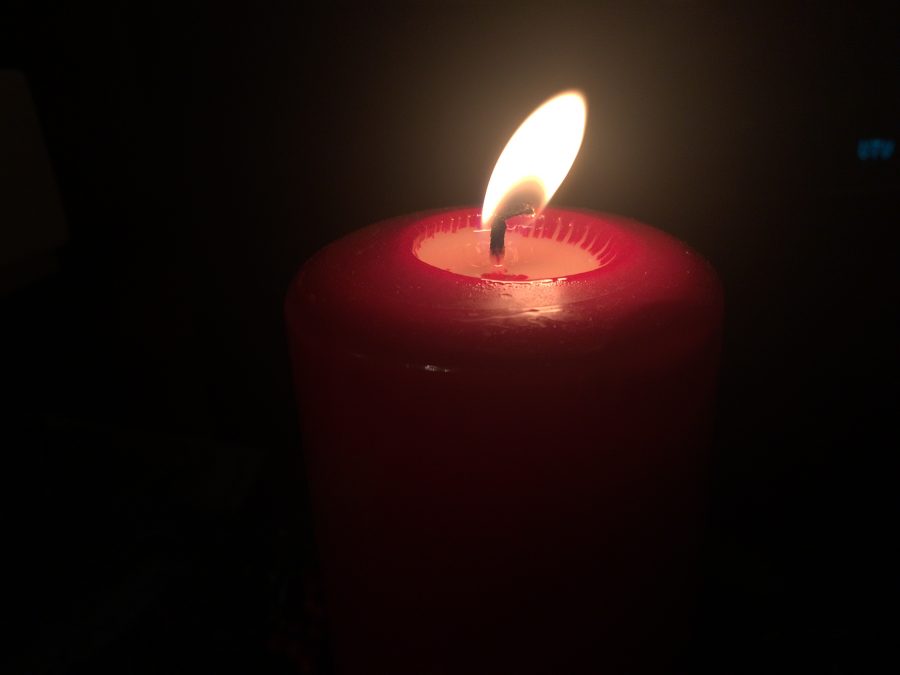
McCarthy Christmas Candle
Kieran’s Our City, Our Town, 24 December 2020

1080a. Daly’s Bridge AKA Shakey Bridge, post refurbishment, December 2020 (picture: Kieran McCarthy).
Kieran’s Our City, Our Town Article,
Cork Independent, 24 December 2020
Celebrating the History of Daly’s Bridge
Over the past two to three years, three bridges in Cork have received much media focus – St Patrick’s Bridge and its cleaning and restructuring, the new Mary Elmes Bridge and its modern design, and thirdly Daly’s Bridge, AKA the Shaky Bridge and its mass cleaning and re-strengthening programme. Such work was spearheaded by Cork City Council.
Perhaps of the three bridges that I have listed the last one, Daly’s Bridge or the Shakey Bridge, opened in 1927, is one which holds the fascination of the public the most. The recent removal of the main body of the bridge to de-clean it off site caused a large tinge of public sadness. Its re-opening this week heralded hope and almost the sense of a valued family member having returned. The bridge’s essence has transcended time from a physical bridging point to one of playfulness, one of fun and one whose shakiness is a key part of Cork’s cultural heritage.
The story of Daly’s Bridge is rich. With the development of Fitzgerald’s Park and the adjacent Rugby Grounds circa 1905, the ferry crossing that had formed a route from Sunday’s Well to Shanakiel came under increasing pressure.
On 28 August 1908 a deputation of residents of Sunday’s Well appeared before the members of Cork Corporation in the then City Hall. Coroner Blake acted as spokesman and noted that he had got a recent letter during that week from Mr Thomas Dooley, proprietor of the ferry at Ferry Walk, stating that he was willing to sell his interest in it (due to his impending retirement) to the Corporation of Cork for £100, if they sought to purchase it.
Coroner Blake outlined that the Corporation had been, as far he knew, owners and proprietors of most of the ferries in the city of Cork, and if they attained Dooley’s ferry rights in question it would be, he believed, “an advantage to the citizens at large”. If the Council thought the proposal a good idea, he suggested that instead of a ferry, a suspension bridge could be erected.
Sir Edward Fitzgerald, councillor, said he believed that the bridge proposal was a necessity and asked that the matter be referred to the Corporation’s Public Works Committee.
On 1 September 1908, the proposed Ferry Walk Bridge was discussed at the Public Works Committee.Sir Edward Fitzgerald said the first thing to be done was to instruct the City Engineer to supply the Committee, at his earliest convenience with the cost of a suspension bridge.
In April 1910, the City Engineer gave particulars regards the site and the approaches to the bridge and a general discussion took place on the question of the situation and character of the new bridge. Shortly afterwards, the proposed cost of a new bridge became a stumbling block for the Corporation to be able to move forward developing the project.
Sixteen years later, the substantial financial contribution by local man James Daly eventually broke the deadlock on funding the suspension bridge project. Born at Moycollop, County Waterford in 1856, James Daly (1856-1942)began his busines life in his native district as a butter and egg merchant. His business acumen was not long in making itself felt, and at an early age he was able to open up as a butter merchant being founder and managing director, of the firm of James Daly and Sons, Ltd., Shandon Street, Dominick Street, and Mulgrave Road. His association with the butter industry extended over 50 years from the 1880s to the early 1930s – over half a century.
Under his own personal supervision James merited for his firm a world-wide reputation and employed many people. In addition to the butter industry, the firm were also proprietors of the Shandon Castle Margarine Factory, which was established until 1905, and erected on the site of the ancient Shandon Castle.
James was one of the trustees of the Cork Butter Exchange. As an agriculturalist, James was well known throughout Cork and Waterford, being the owner of large farms in each of these counties, while he also possessed extensive fishing preserves on the River Blackwater, and game preserves in the same vicinity. James was also a Justice of the Peace, a member of the Cork Chamber of Commerce, and a member of the National Liberal Club of London.
The decision was made by City Engineer, Stephen Farrington that the new bridge should be a steel suspension bridge, a type popular in the early decades of the twentieth century, though few were built in Ireland. The decision was made to purchase a bridge from the English bridge manufacturers David Rowell & Company.
In his 3 February 1927 report, Stephen Farrington said he was notified by Messrs Rowell & Co that the steel erectors were coming over that week to start work on the suspension bridge at Ferry Walk. In late February 1927,the new suspension footbridge was rapidly nearing completion.
The formal opening of Daly’s Bridge took place on Saturday 9 May 1927. Very Rev Canon O’Sullivan presided at the function. Mr M O’Driscoll, PC on behalf of Mr James Daly opened the bridge.
Mr O’Driscoll said that he felt that a very great honour had been conferred on him in asking him to formally open the bridge, which “would do so much to enhance the attractions of the district, and at the same time confer such as substantial benefit on the citizens in general, and on the residents of Sunday’s Well in particular”.
For more information on the story of Daly’s Bridge aka The Shakey Bridge, check out Kieran’s History Trails on www.corkheritage.ie
Happy Christmas to everyone.
Caption:
1080a. Daly’s Bridge AKA Shakey Bridge, post refurbishment, December 2020 (picture: Kieran McCarthy).
Evening Echo, Shalom Park, 17 December 2020
Evening Echo is a public artwork by New Zealand artist Maddie Leach. It is sited on old gasometer land gifted by Bord Gáis to Cork City Council in the late 1980s. This site was subsequently re-dedicated as Shalom Park in 1989. The park sits in the centre of the old Cork neighbourhood known locally as ‘Jewtown’. This neighbourhood is also home to the National Sculpture Factory.
This year the last night of Hanukkah is Thursday 17 December and offers the only opportunity to see the tall ‘ninth lamp’ alight until next year. The cycle begins 10 minutes before sunset, which occured this year at 4.13pm, and continued for 30 minutes after sunset when the ninth lamp was extinguished.
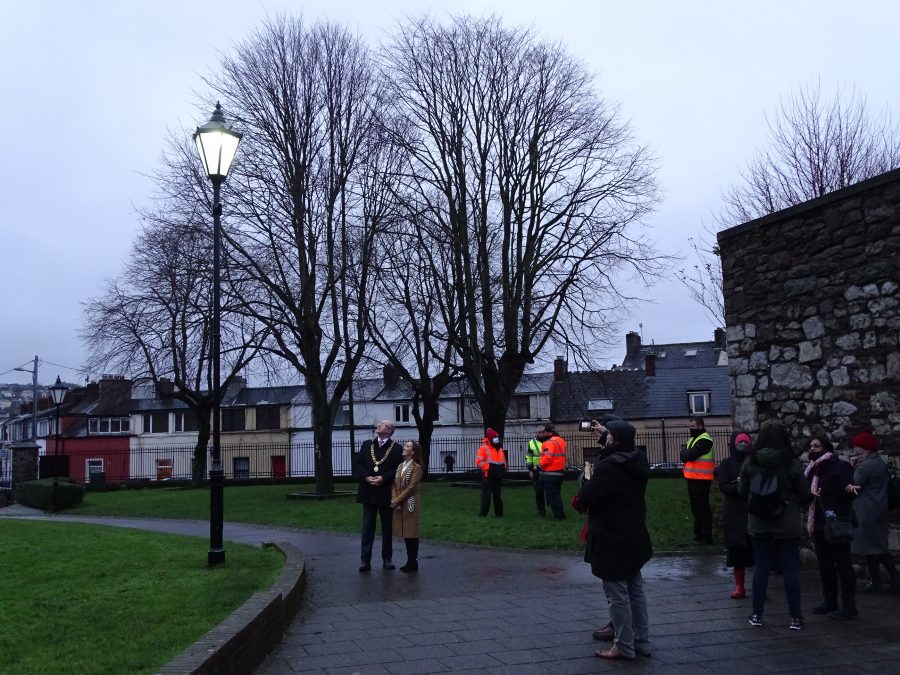

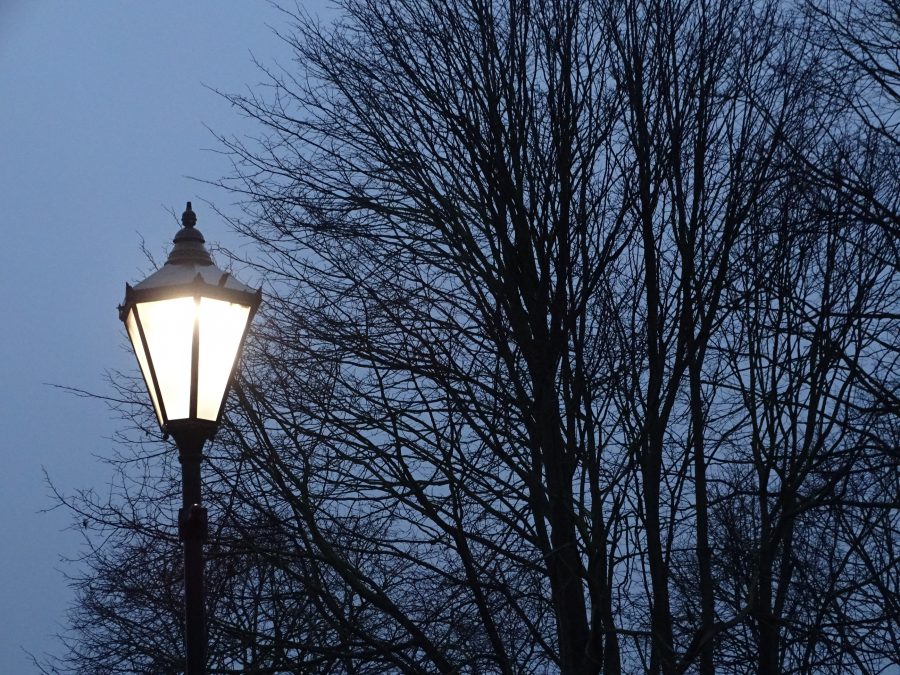
Cllr McCarthy: Opening of Douglas Library will support social and cultural inclusion
Independent Cllr Kieran McCarthy has welcomed the reopening of Douglas Library in Douglas Village Shopping Centre. The library will be a transformed space both in design and enhanced services. The refurbished library includes a complete transformation of the children’s space, including a new children’s fiction area, a larger children’s story time area and a new personalised kiosk for the children and families to use.
The Listening Lounge is new to the adult area and will be a space for the public to listen to audio books and music on cd and vinyl. It will be a relaxing and calm space. My Open Library will be part of Douglas Library early in the new year and will significantly increase the opening hours for the public.
Plans are also being finalised to support those with dementia in the community, including a new Tovertafel magic table and memory café which will be a great addition to our Age Friendly Libraries initiatives.
A Per Cent for Art Commission has been awarded to two Cork based textile artists as part of the reopening of the refurbished Library. Taking its inspiration from the historic textile industry of the Douglas area the proposal includes a strong community engagement element with nursing homes and local schools. The end piece will be a textile wall hanging, a focus for discussion of the local history of the area for many years to come.
Cllr McCarthy noted: “The staff of Cork City Libraries put in extra hours adding new items to ensure the stock of Douglas Library will be second to none, providing the most up to date titles available to the people of Douglas and the surrounding areas. The library will continue to host many activities, book clubs, writing groups and craft activities for all ages within the community. The City Council’s intention is that the library will continue to proactively support learning, diversity and social and cultural inclusion”.
Independent Cllr Kieran McCarthy has welcomed the reopening of Douglas Library in Douglas Village Shopping Centre. The library will be a transformed space both in design and enhanced services. The refurbished library includes a complete transformation of the children’s space, including a new children’s fiction area, a larger children’s story time area and a new personalised kiosk for the children and families to use.
The Listening Lounge is new to the adult area and will be a space for the public to listen to audio books and music on cd and vinyl. It will be a relaxing and calm space. My Open Library will be part of Douglas Library early in the new year and will significantly increase the opening hours for the public.
Plans are also being finalised to support those with dementia in the community, including a new Tovertafel magic table and memory café which will be a great addition to our Age Friendly Libraries initiatives.
A Per Cent for Art Commission has been awarded to two Cork based textile artists as part of the reopening of the refurbished Library. Taking its inspiration from the historic textile industry of the Douglas area the proposal includes a strong community engagement element with nursing homes and local schools. The end piece will be a textile wall hanging, a focus for discussion of the local history of the area for many years to come.
Cllr McCarthy noted: “The staff of Cork City Libraries put in extra hours adding new items to ensure the stock of Douglas Library will be second to none, providing the most up to date titles available to the people of Douglas and the surrounding areas. The library will continue to host many activities, book clubs, writing groups and craft activities for all ages within the community. The City Council’s intention is that the library will continue to proactively support learning, diversity and social and cultural inclusion”.
Cllr McCarthy: Douglas Library Set to Open, 14 December 2020
14 December 2020, “Following a question posed by Independent councillor Kieran McCarthy, who requested an update on the progress of the reopening of the library”, Reopening date of Douglas Library revealed; refurbished library to offer new services, https://www.echolive.ie/corknews/arid-40190784.html
Cllr McCarthy: Cork’s ‘Shaky Bridge’ set to reopen this weekend following €1.7m restoration
14 December 2020, “The Councillor and historian has long been a champion of the suspension pedestrian bridge, one of the last of its kind in operation in the country”,
Cork’s ‘Shakey Bridge’ set to reopen this weekend following €1.7m restoration,
Cork’s ‘Shakey Bridge’ set to reopen this weekend following €1.7m restoration – Cork Beo
Kieran’s Our City, Our Town, 10 December 2020

Aftermath of the Burning of Cork on St Patrick’s Street photograph by W Hogan (source: National Library of Ireland).
Kieran’s Our City, Our Town Article,
Cork Independent, 10 December 2020
Remembering 1920: The Burning of Cork
It was a night like no other in Cork’s War of Independence. The Cork Examiner records that about 7.30pm on Saturday night, 11 December 1920 auxiliary police were ambushed near Dillion’s Cross on the way to Cork Barracks. Bombs were thrown at the lorry and several of the occupants were injured, some badly. Reprisals began in the locality of the ambush, and during the night several houses in the district were burned. Buttimer’s Shop and Brian Dillion house were targeted. The latter House, which had a tablet on it dedicated to Irish Fenian Brian Dillion, was completely gutted. Rifle shots rang out and the crackling burning of timber was heard.
Between 8pm and 10pm volleys of revenge gunfire from auxiliary police and Black and Tans reverberated through the flat of the city and created considerable alarm as people stampeded away in various directions. Many people elected to stay in hotels and others sought the hospitable shelter of friend’s houses in the neighbourhood in which they happened at the time. The people sought their homes, extinguished all lights, and then passed through many hours of fear.
Passengers on the last tram to St Luke’s Cross, which left the Statue at 9pm had an eventful journey. The car had got about 60 to 70 yards beyond Empress Place Police Station on Summerhill North when a number of armed men in police uniform carrying carbines, and accompanied by auxiliaries, held it up. They ordered all the passengers off at the point with revolvers. Male passengers were ordered to line up for searching. Some tried to run and a voice rang out, “I’ll shoot anyone who runs”. Shots were fired in the air while the searches were being conducted.
The tram car was smashed up and was brought back by the conductor to the Fr Mathew Statue, who at that point was ordered off. It was set on fire and completely destroyed.
It was hoped that when curfew hour was reached there would be cessation of the firing and explosions, but such hopes were not realised: in fact as the night advanced the situation became more terrifying, and the people especially women and children were rendered helpless amidst fire and shots by Black and Tans stalking the streets with rifles and revolvers. About 10pm, following explosions, Messrs Grants’ Emporium, in St Patrick’s Street, was found to be ablaze.
The Superintendent of the City of Cork Fire Brigade, Alfred Hutson,received a call at 10.30pm to extinguish the fire at Grants. He found that the fire had gained considerable headway and the flames were coming through the roof. He got three lines of hose to work—one in Mutton Lane and two in Market Lane, intersecting passages on either side of these premises. With a good supply of water they were successful in confining the fire to Grant’s and prevented its spread to that portion running to the Grand Parade from Mutton Lane, while they saved, except with slight damage, the adjacent premises of Messrs Hackett (jeweller) and Haynes (jeweller).
The Market – a building mostly of timber – to the rear of Grants was found to be in great danger. Except for only a few minor outbreaks in the roof the fire brigade was successful in saving the Market and other valuable premises in Mutton Lane. The splendid building of Grant’s though with its stock was reduced to ruins.
During the fire-fighting at Grants Alfred Hutson received word from the Town Clerk that the Munster Arcade was on fire, just some doors from where he was. This was about 11.30pm. He sent some of his men and appliances available to contend with it. Shortly after he got word that the Cash’s premises were on fire. He shortened down hoses at Mutton Lane and sent all available stand-pipes, hoses and men to contend with this fire as well.
Hutson’s men found both the Munster Arcade and Cash’s well alight from end to end, with no prospect of saving either, and the fire spreading rapidly to adjoining properties. All the hydrants and mains that they could possibly use were brought to bear upon the flames and points were selected where the fire may be possibly checked and their efforts concentrated there.
The flames ranged with great intensity, and within an hour, buildings were reduced to ruins. Owing to the inflammatory nature of the materials in these premises, or as the result of petrol having been sprinkled within the buildings, the conflagrations became most fierce and the blocks of buildings running between St Patrick’s Street and Oliver Plunkett Street on one side and Cook Street and Merchant street on the other side became involved. It was impossible to subdue such outbreaks.
In the early hours of Sunday morning at 2.50am in the upper end of Dublin Hill in Blackpool the Black and Tans encroached on the houses of the Delaney family. IRA members Joseph Delaney, aged about 24, was shot dead and his brother, 30-year old Cornelius and his 50 year old uncle, William Dunlea, were wounded, the former very dangerously. All were shot at point blank range by uniformed soldiers. The two wounded men were removed to the Mercy Hospital where Cornelius succumbed to his wounds.
It was approaching 4am when it was discovered that the work of destruction continued. At that time the City Hall and Carnegie Library became ablaze. Both of these buildings were gutted, only the walls left standing. The upper portion of City Hall including the clock tower fell in. Such was the intensity of the fires the firemen were driven out of the buildings.
As dawn broke on Sunday morning, 12 December, residents of Cork were then able to see the picture of Saturday night’s work of devastation. Fine buildings, with highly valuable stock, had been wiped out, and thousands of people were to become unemployed.
In one twenty-four period, over four acres of Cork City’s Centre had been reduced to ruins – 2,000 people had lost their jobs, and an estimated three million pounds of damage had been inflicted on Cork’s City Centre building stock. Nearly one hundred businesses and homes had been destroyed or badly damaged by fire and looting.
Kieran’s latest book Witness to Murder, The Inquest of Tomás MacCurtain is now available to purchase online (co-authored with John O’Mahony 2020, Irish Examiner/www.examiner.ie).
Caption:
1078a. Aftermath of the Burning of Cork on St Patrick’s Street photograph by W Hogan (source: National Library of Ireland).
RTE Radio 1 Interview with Kieran on The Burning of Cork 1920, 5 December 1920
5 December 2020, “This week coming marks 100 years since the Burning of Cork. The Black and Tans destroyed homes, dozens of businesses and buildings. To take a look at this a bit more we’re joined by a local Cork historian Cllr Kieran McCarthy”, The Burning of Cork, 1920, The Business (rte.ie)
